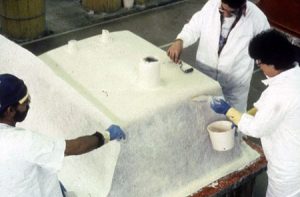 Two steps for putting fiberglass lamination into action
Two steps for putting fiberglass lamination into action
August 25, 2014 REDWIRE is news you can use from leading suppliers. Powered by FRASERS.
Posted by Precisioneering DKG
Fibreglass Reinforced Plastic, Corrosion Resistant Fibreglass, Reinforced Plastic Grating, Air Ducts, Fans & Blowers... Read more
Subscribe
Free REDWIRE e-newsletter

From planes, trains and automobiles, fiberglass lamination is a plastics fabrication technique used to reinforce material surfaces, whether it is an airplane nose cone, a passenger train seat or the interior panel of an automobile door.
Fiberglass is a commonplace, economically affordable material containing plastic substances made largely from thin, individual fibers of glass.
Fiberglass is a woven, reinforced material manufactured into everyday commercial fiberglass products, including flooring, panels and storage bins, designed with reasonable tensile strength, resistance to external stresses or damage and ultra lightweight properties.
Take the one-two step fiberglass lamination challenge to understand how the refined lamination technique creates industrial components from boat hull to wind-turbine blades.
What is fiberglass lamination?
The fiberglass lamination process involves using thin fiberglass sheets, layer upon layer, onto the surface of another material to boost the overall strength, insulation and support to the material of the existing part, machinery or equipment.
Fiberglass is then formed into a mould containing a resin-based mixture, including epoxy or polyester, which is then hardened until the desired finish of the fiberglass workpiece is achieved.
Fiberglass lamination technique no. 1 – The Hand Layup:
Hand layups have nothing to do with making a basket, but they are responsible for creating components for the aviation, automotive and wind technology sectors.
Known as an open-mould application, the hand layup process includes fiberglass and secondary fabric materials are manually placed into a mould embedded with a specially-formulated resin mixture.
While the fiber materials are soaking within the resin solution, brushes and rollers evenly spread the lamination substance to the area and remove trapped air bubbles.
The material is then placed into a vacuum-pressured system (called a vacuum-assisted resin transfer mould) infusing the resin to penetrate throughout the fiberglass compound inside the mould for a specific time period until the desired result is achieved.
Fiberglass lamination technique no. 2 – Spray Layup:
Wonder why you the underbelly of an installed household bathtub or a commercial swimming pool are not their best side? While spray layup applications provide excellent surface finish on one side, they produce a rough surface exterior on its opposite side.
As the name suggests, spray layup involves resin and reinforced compounds are sprayed directly onto the mould, which contrasts from the manual application of hand layup applications.
Despite the shortcoming of the one-sided smooth finish, spray layup as a lamination process is still superior when it comes to saving a dime thanks to low material, production and tooling costs for small to medium scaled projects.
See why Precisioneering Ltd. is fiberglass fabricating for the future – today.
Share
Posted by Precisioneering DKG
Fibreglass Reinforced Plastic, Corrosion Resistant Fibreglass, Reinforced Plastic Grating, Air Ducts, Fans & Blowers... Read more
